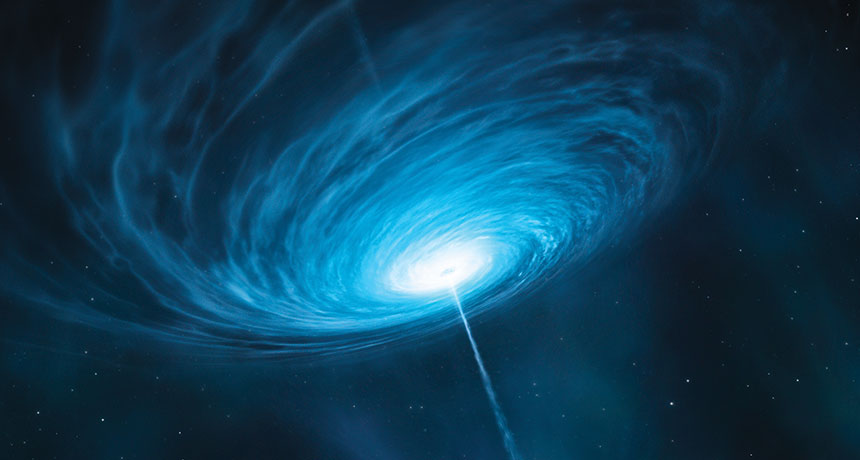Hurricane at this galaxy’s center is wicked fast
Winds circling one black hole whip by at almost one-fifth the speed of light

This illustration depicts winds circling the black hole at the center of a quasar. A new study finds that the ‘hurricane’ enveloping one quasar whips around at a speed equal to one-fifth the speed of light.
M. Kornmesser/ESO
When visiting the center of a galaxy nicknamed J0230, pack a sturdy windproof jacket. There, you will encounter a galactic hurricane with winds whipping about at some 200 million kilometers (124 million miles) per hour. That’s nearly one-fifth the speed of light. At that speed, it would take you just 0.7 seconds to circle around Earth.
These winds are about 625,000 times as fast as the highest sustained winds in any hurricane seen on Earth. They also are the fastest known winds around a quasar — a blazing disk of debris around a supermassive black hole. Researchers reported their results in the March 21 Monthly Notices of the Royal Astronomical Society.
These quasar winds get their speed from the intense radiation emitted by the disk. It glows as bright as roughly 22 trillion suns! The light comes from gases slamming together as they orbit a black hole with 2.2 billion times as much mass as the sun.
Despite taking up a relatively little space, the quasar can launch winds powerful enough to shape its entire home galaxy. That’s because the winds can fling gases out of the galaxy, robbing star-forming regions of the fuel they need to make new stars.
The quasar sits in the constellation Cetus. Its light takes about 11 billion years to reach Earth. The quasar’s winds top those of the previous record holder — the quasar PG 2302+029 — by about 14 million kilometers (8.7 million miles) per hour.
Power Words
(for more about Power Words, click here)
black hole A region of space having a gravitational field so intense that no matter or radiation (including light) can escape.
constellation Patterns formed by prominent stars that lie close to each other in the night sky. Modern astronomers divide the sky into 88 constellations, 12 of which (known as the zodiac) lie along the sun’s path through the sky over the course of a year. Cancri, the original Greek name for the constellation Cancer, is one of those 12 zodiac constellations.
galaxy A massive group of stars bound together by gravity. Galaxies, which each typically include between 10 million and 100 trillion stars, also include clouds of gas, dust and the remnants of exploded stars.
hurricane A tropical cyclone that occurs in the Atlantic Ocean and has winds of 119 kilometers (74 miles) per hour or greater. When such a storm occurs in the Pacific Ocean, people refer to it as a typhoon.
mass A number that shows how much an object resists speeding up and slowing down — basically a measure of how much matter that object is made from.
quasar Short for quasi-stellar light source. This is the brilliant core of some galaxy (massive collections of stars) that contains a super-massive black hole. As mass from the galaxy is pulled into that black hole, a huge quantity of energy is released, giving the quasar its light.
radiation (in physics) One of the three major ways that energy is transferred. (The other two are conduction and convection.) In radiation, electromagnetic waves carry energy from one place to another. Unlike conduction and convection, which need material to help transfer the energy, radiation can transfer energy across empty space.
star Thebasic building block from which galaxies are made. Stars develop when gravity compacts clouds of gas. When they become dense enough to sustain nuclear-fusion reactions, stars will emit light and sometimes other forms of electromagnetic radiation. The sun is our closest star.







